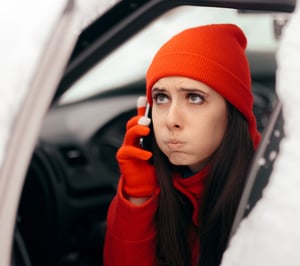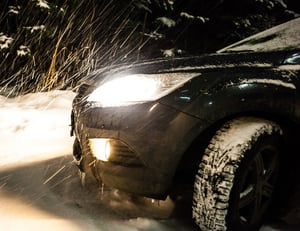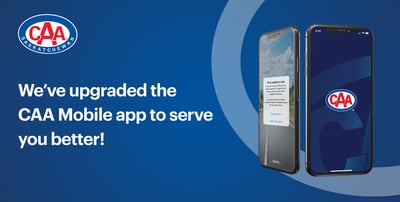It can happen very quickly. One minute you’re driving down the road and the next minute you’re in the ditch. Icy roads that are covered with a layer of snow can be treacherous and can catch you by surprise. Prairie winters can be challenging – freezing weather and snow, and blustery winds, are just the beginning.
Even when you have a short distance to go, a snowstorm or blizzard can reduce the visibility to near zero making the drive extremely difficult. Other reasons that can contribute to being stranded include vehicle break down, a flat tire, a dead battery, or no fuel.
So, you’re stuck or stranded, what should you do?
 Dr. Gordon Giesbrecht gives us advice on how to stay safe.
Dr. Gordon Giesbrecht gives us advice on how to stay safe.
“Don’t ever leave your vehicle – period,” says physiologist and University of Manitoba professor Dr. Gordon Giesbrecht. Known as Professor Popsicle, Giesbrecht is a leading authority on freezing to death. The king of chill has lowered his own body temperature to the threshold of hypothermia a mind-numbing 33 times – all in the name of research.
“Cold, wet and wind are the deadly triad of hypothermia,” he explains. “If your car slides into a snowbank, or you run out of gas, or break down, do not leave to look for help.” You may feel kind of rattled from the incident. Stay calm. Figure out where you are and if you’re injured (due to an automobile accident) call 911 to get help immediately. If you’re ok, then call for roadside assistance. The phone number is on the back of your CAA membership card or program the number into your phone: 1-800-222-4357.
Giesbrecht explains that once you’ve called for roadside assistance then wait it out. “Ninety-five percent of searches are successful within 24 hours.” Stranded drivers tend to think they’ll never be found, but they will. There’s also a tendency to panic about freezing to death within a few hours. “Even at -40°C, you can easily survive 24 hours in your vehicle.” To stay warm, clear your exhaust pipe of snow (to avoid carbon monoxide poisoning) and intermittently run the vehicle for heat. When running the engine, crack a window for ventilation. Giesbrecht says that prevention is the best medicine. Before leaving town make sure you have a full tank of gas, a vehicle in good working condition, and a roadside safety kit which can be purchased at your local CAA Store. Alternatively, you can also make your own.
Giesbrecht says that prevention is the best medicine. Before leaving town make sure you have a full tank of gas, a vehicle in good working condition, and a roadside safety kit which can be purchased at your local CAA Store. Alternatively, you can also make your own.
Some of the items you pack in your roadside kit can help you feel more comfortable while you wait.
• Mobile phone charger and extra cord: Alleviate your anxiety of your phone battery dying by having a phone charger on hand. Mobile phone batteries can be affected by the cold and will need to be charged sooner.
• Sleeping bag or more compact survival blanket: Stay comfortable. A sleeping bag or survival blanket can be used for added warmth and comfort.
• Extra clothes: Stay warm. Having extra outdoor clothing is a good idea. For shorter trips you may grab a jacket and gloves that aren’t quite as warm as you would need if you’re stranded in cooler temperatures.
• Non-perishable food: Chocolate will give you an energy boost to help keep you warm. If you love chocolate, it may also help you feel less miserable about your current circumstances. Granola or energy bars are good to pack and store as well. Bottled water may freeze in your vehicle and according to Geisbrecht isn’t as important as you can live without water for three days – longer in the winter.
• Flashlight and spare batteries: In the winter there are fewer daylight hours. Your phone has a flashlight but if it’s plugged into the charger it’s not as mobile as you may need. A flashlight will help you see in the dark. You could also shine it to alert others where you are.
Being stuck or stranded for a short time is an unhappy inconvenience. It’s important to take precautions to ensure your safety. Remember: Do not leave your vehicle. Stay warm. Pack a roadside kit. Download the CAA Mobile app on your phone before you leave home. You can request roadside assistance and track the status of your request through the app. Visit caask.ca/safety for more safe driving tips.



